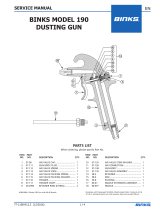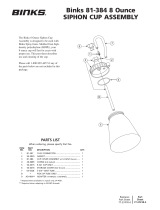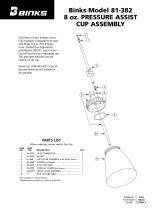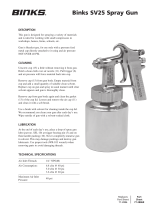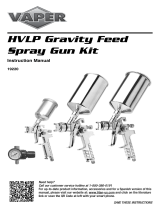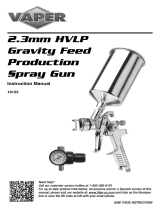Page is loading ...

EN
77-2463-R19.3 (1/2017) 1 / 12
SERVICE MANUAL
BINKS MACH 1, MACH 1V,
HVLP SPRAY GUN
MACH 1 WITH ADJUSTABLE FLUID INLET
(6202-XXXX-X)
4
Illustration Key
1. Lightweight Air Nozzle
2. Fluid Inlet 3/8" NPS(m)
3. Extra Smooth Trigger Action
4. Stainless Steel Fluid Nozzle and Needle
5. Side Port Control
6. Fluid Control Knob
7. Forged Aluminum Body
8. Air Inlet 1/4" NPS(m)
The Binks MACH 1 HVLP gun is a
top quality high performance air spray
gun. You only have to pick it up to
feel the difference. Its superbly
balanced forged aluminum body offers
the operator extra comfort and control.
All of the gun’s components are
machined and finished to exacting
tolerances and only the best materials
are used, ensuring years of peak
efficiency.
The MACH 1 HVLP airspray gun has
special nozzles and modifications that
allow it to operate at high transfer
efficiencies in compliance with the
“California South Coast Air Quality
Management District” regulations as
a “high volume, low pressure”
airspray gun.
The air inlet passage in the gun body
incorporates a venturi which limits
airflow. High pressure, low volume
airflow is converted to high volume,
low pressure at this point. Special air
and fluid nozzles enable the gun to
atomize fluid at low air pressures and
velocities, creating the “soft spray”
effect for high transfer efficiencies.
To obtain optimum performance from
your new MACH 1 HVLP airspray
gun, read all instructions carefully.
Package Contents
Please note that your Binks MACH 1
HVLP airspray gun package was
shipped with the following contents. If
anything in the following list is miss-
ing, call 1-800-992-4657 for a prompt
shipment to you of the missing item.
1 MACH 1 Spray Gun
1 Part Sheet ...........77-2463
1 Gunners Mate
1 Gun Brush
1 Cleaning Brush
5
6
7
2
1
3
8
Some regulatory agencies prohibit the operation of HVLP spray guns above 10 psi nozzle atomizing pressure. Users subject to this type of
regulation should not exceed 10 psi (50 psi gun inlet pressure). See Air Pressure Recommendations, page 7 and General Spray Instructions,
page 5. It is recommended that the nozzle test gauge (see below) be used to confirm actual nozzle operating pressure.
It may also be a requirement of some regulatory agencies that users have this gauge nozzle available on site to verify that the gun is
being operated within the limits of applicable rules.
IMPORTANT REGULATORY NOTE

EN
77-2463-R19.3 (1/2017)2 / 12
Binks reserves the right to modify equipment specification without prior notice.
LOCK OUT / TAG-OUT
Failure to de-energize, disconnect, lock out and tag-out all power
sources before performing equipment maintenance could cause
serious injury or death.
OPERATOR TRAINING
All personnel must be trained before operating finishing
equipment.
EQUIPMENT MISUSE HAZARD
Equipment misuse can cause the equipment to rupture,
malfunction, or start unexpectedly and result in serious injury.
PROJECTILE HAZARD
You may be injured by venting liquids or gases that are released
under pressure, or flying debris.
PINCH POINT HAZARD
Moving parts can crush and cut. Pinch points are basically any
areas where there are moving parts.
INSPECT THE EQUIPMENT DAILY
Inspect the equipment for worn or broken parts on a daily basis.
Do not operate the equipment if you are uncertain about its
condition.
In this part sheet, the words WARNING, CAUTION and NOTE are used to
emphasize important safety information as follows:
Hazards or unsafe practices which
could result in minor personal injury,
product or property damage.
!
CAUTION
Hazards or unsafe practices which
could result in severe personal
injury, death or substantial property
damage.
!
WARNING
Important installation, operation or
maintenance information.
NOTE
Read the following warnings before using this equipment.
READ THE MANUAL
Before operating finishing equipment, read and understand all
safety, operation and maintenance information provided in the
operation manual.
WEAR SAFETY GLASSES
Failure to wear safety glasses with side shields could result in
serious eye injury or blindness.
NEVER MODIFY THE EQUIPMENT
Do not modify the equipment unless the manufacturer provides
written approval.
IT IS THE RESPONSIBILITY OF THE EMPLOYER TO PROVIDE THIS INFORMATION TO THE OPERATOR OF THE EQUIPMENT.
FOR FURTHER SAFETY INFORMATION REGARDING THIS EQUIPMENT, SEE THE GENERAL EQUIPMENT SAFETY BOOKLET (77-5300).
KNOW WHERE AND HOW TO SHUT OFF THE EQUIPMENT
IN CASE OF AN EMERGENCY
PRESSURE RELIEF PROCEDURE
Always follow the pressure relief procedure in the equipment
instruction manual.
NOISE HAZARD
You may be injured by loud noise. Hearing protection may be
required when using this equipment.
STATIC CHARGE
Fluid may develop a static charge that must be dissipated through
proper grounding of the equipment, objects to be sprayed and all
other electrically conductive objects in the dispensing area. Improper
grounding or sparks can cause a hazardous condition and result in
fire, explosion or electric shock and other serious injury.
PROP 65 WARNING
WARNING: This product contains chemicals known to the
State of California to cause cancer and birth defects or other
reproductive harm.
WEAR RESPIRATOR
Toxic fumes can cause serious injury or death if inhaled.
Wear a respirator as recommended by the fluid and solvent
manufacturer’s Safety Data Sheet.
TOXIC FLUID & FUMES
Hazardous fluid or toxic fumes can cause serious injury or death if
splashed in the eyes or on the skin, inhaled, injected or
swallowed. LEARN and KNOW the specific hazards or the fluids
you are using.
KEEP EQUIPMENT GUARDS IN PLACE
Do not operate the equipment if the safety devices have been
removed.
!
WARNING
AUTOMATIC EQUIPMENT
Automatic equipment may start suddenly without warning.
FIRE AND EXPLOSION HAZARD
Improper equipment grounding, poor ventilation, open flame or
sparks can cause a hazardous condition and result in fire or
explosion and serious injury.
MEDICAL ALERT
Any injury caused by high pressure liquid can be serious. If you
are injured or even suspect an injury:
• Go to an emergency room immediately.
• Tell the doctor you suspect an injection injury.
• Show the doctor this medical information or the medical alert
card provided with your airless spray equipment.
• Tell the doctor what kind of fluid you were spraying or
dispensing.
GET IMMEDIATE MEDICAL ATTENTION
To prevent contact with the fluid, please note the following:
• Never point the gun/valve at anyone or any part of the body.
• Never put hand or fingers over the spray tip.
• Never attempt to stop or deflect fluid leaks with your hand,
body, glove or rag.
• Always have the tip guard on the spray gun before spraying.
• Always ensure that the gun trigger safety operates before
spraying.

EN
77-2463-R19.3 (1/2017) 3 / 12
TYPES OF INSTALLATION
5/16”
1/4”
Only 34 PSI at gun inlet
25 feet of 1/4” I.D. hose causes
a drop of 26 PSI between the
air supply and the gun.
(NOT RECOMMENDED)
48 PSI at gun inlet
25 feet of 5/16” I.D. hose
causes a drop of 12 PSI
between the air supply
and the gun. For this reason
Binks recommends the use
of 5/16” hose.
(RECOMMENDED)
With 60 psi applied at air supply
CONNECTING GUN TO
“PRESSURE ASSISTED”1 QT. CUP
(Figure 1)
The stainless steel pressure-assisted 1 quart
cup utilizes a low pressure air bleed port on
the gun head to slightly pressurize the cup
and provide fluid flow to the nozzle. A
check valve prevents the cup from depres-
surizing when the gun trigger is released
and airflow stops.
To connect the gun to the cup, remove
the plug (22) in the gun head and install
the hose barb fitting provided with cup
assembly. Attach cup assembly to 3/8"
NPS fluid inlet connection and firmly
tighten. The siphon tube should be angled
toward the front of the gun, i.e. under the
nozzles, and the pressure hose in the cup
lid positioned to the left of the trigger.
Connect check valve assembly hose from
barb fitting on gun head to check valve
inlet fitting on cup cover. Make sure the
check valve is connected so the air comes
from the gun, through the check valve,
into the cup.
Air pressure for atomization is regulated
at the extractor. The flow of the fluid is
adjusted by the fluid valve control knob
on gun, viscosity of paint and air
pressure.
PRESSURE CUP HOOKUP
(Figure 2)
For fine finishing with limited spraying.
Air pressure for atomization is regulated
at extractor; fluid pressure at cup regula-
tor. Pressure cup is also available less
regulator.
PRESSURE TANK HOOKUP
(Figure 3)
For medium production spraying (single
regulator). Air pressure for atomization is
regulated at extractor, fluid pressure at
tank regulator.
PRESSURE TANK WITH
2 REGULATORS (Figure 4)
The pressure to the tank is regulated by
the first regulator. The pressure for
atomization is regulated by the second
regulator.
PRESSURE CIRCULATING
HOOKUP (Figure 5)
For heavy production spraying. Air pres-
sure atomization regulated at extractor.
Fluid pressure regulated at fluid regulator.
AIR PRESSURE
Atomizing pressure must be set prop-
erly to allow for the drop in air pres-
sure between the regulator and the
spray gun.
Binks oil and water extractor is important.
Achieving a fine spray finish without the use of a good oil and water extractor is virtually
impossible.
A Binks regulator / extractor serves a double purpose. It eliminates blistering and spotting
by keeping air free of oil and water, and it gives precise air pressure control at the gun.
Binks recommends using Model HFRL-508 Oil and Water Extractor / Regulator. See your
local distributor for other models.
Cross section view
showing comparison of inside
hose diameters (actual size).
60 lbs. regulated pressure
Air
Siphon Cup
Oil & Water
Extractor
Fluid Pressure Cup
FIG 3
Air
Fluid
Outlet
Air
Inlet
Oil & Water Extractor
Fluid
Pressure
Tank
FIG 4
FIG 5
Fluid
Regulator
Air Supply
Air Supply
Fluid
Pressure
Tank
Oil &
Water
Extractor
Air
FIG 1
FIG 2
Air
Cup Regulator
Oil & Water
Extractor
Fluid

EN
77-2463-R19.3 (1/2017)4 / 12
OPERATION AND MAINTENANCE FOR MACH 1 HVLP SPRAY GUN
Your new MACH 1 HVLP spray gun is
exceptionally rugged in construction and
is built to stand up under hard, continu-
ous use. However, like any other fine
precision instrument, its most efficient
operation depends on a knowledge of its
construction, operation and mainte-
nance. Properly handled and cared for, it
will produce beautiful, uniform finishing
results long after other spray guns have
worn out.
SET-UP FOR SPRAYING
Connecting Gun To Air Hose
Air should be supplied by a suitable
length of 5/16" diameter air hose fitted
with a 1/4" NPS(f) connection at gun
end. For hose lengths over 50', use 3/8"
diameter hose.
Connecting Gun To Fluid Hose
Fluid should be supplied by a suitable
length of 3/8" diameter fluid hose fitted
with a 3/8" NPS(f) connection at gun
end. 1/4" diameter hose is recommended
for use with low viscosity fluids. (Fluid
hoses of different composition are avail-
able for special fluids.)
SPRAY GUN CLEANING
INSTRUCTIONS
In certain states it is now against the law
to spray solvents containing Volatile
Organic Compounds (VOC)’s into the
atmosphere when cleaning a spray gun.
In order to comply with these air quality
laws Binks recommends one of the fol-
lowing two methods to clean your spray
finishing equipment:
1. Spray solvent through the gun into a
closed system. An enclosed unit or
spray gun cleaning station condenses
solvent vapors back into liquid form
which prevents escape of VOC’s into
the atmosphere.
2. Place spray gun in a washer type
cleaner. This system must totally
enclose the spray gun, cups, nozzles
and other parts during washing, rins-
ing and draining cycles. This type of
unit must be able to flush solvent
through the gun without releasing
any VOC vapors into the atmosphere.
Additionally, open containers for storage
or disposal of solvent or solvent-con-
taining cloth or paper used for surface
preparation and clean-up may not be
used. All containers shall be nonabsor-
bent.
Pointers On Cleaning
When used with 1 quart cup, relieve
pressure in the cup. Then unscrew,
empty and carefully rinse cup out with
thinners. Place clean thinners in the cup
and spray this through the gun until it is
clean. Blow air through gun to dry it.
When Used With Pressure
Container
Shut off air supply to container and
release the pressure on the container.
Hold a piece of cloth wadded in the
hand over the gun nozzle (3) and pull
the trigger. The air will back up through
the fluid nozzle and force the fluid out
of the hose into the container. Empty
container. Put enough thinner into the
container to wash hose and gun thor-
oughly and spray this through the gun
until it is clean. Then blow out the fluid
hose to dry it and remove all traces of
fluid by attaching it to the air line.
When used with Paint
Circulating System
Shut off fluid supply and remove fluid
hose from gun. Clean as gun used with
siphon cup or pressure container or con-
nect quick release on paint line solvent
line. To ensure a clean air supply to your
spray gun, use Binks oil and water
extractor. See your Binks distributor for
the correct model.
GENERAL MAINTENANCE
To Replace Air Valve and
Spindle Assembly
Remove fluid control knob (23), spring
(18) and fluid needle (20). Unscrew
housing (19) and remove spindle assem-
bly (17) with springs (16 & 18), seal
retainers (15) and o-rings (14).
Lubricate new o-rings with Gunners
Mate. Assemble components using fluid
needle. Place this assembly along with
housing (19) into gun body and screw
into position. Remove fluid needle and
tighten housing.
To Replace Needle Seal and
Gland Adapter in Fluid Inlet
Remove fluid control knob (23) and
spring (18) and pull out fluid needle
(20). Unscrew packing nut (31) and
remove spring (30) and seal backup
(29). Using a no. 8 x 1-1/4 coarse thread
wood screw (Binks part no. 20-6536) or
a small sheet metal screw, remove the
needle seal (28) and gland adapter (27).
Replace gland adapter (27) and needle
seal (28). Re-insert seal backup (29),
spring (30) and screw on packing nut
(31) a couple of turns so it fits loosely
by hand. Reassemble fluid needle (20),
spring (18) and fluid control knob (23).
Finally, tighten packing nut (31) until it
bottoms out on fluid inlet (26).
CAUTION
All parts on a spray gun should be
screwed in hand tight at first; this
will avoid the possibility of cross
threading the parts. If the parts
cannot be turned by hand easily,
make sure you have the correct
parts, unscrew, realign, and try
again. NEVER use undue force in
mating parts.
!

EN
77-2463-R19.3 (1/2017) 5 / 12
Binks MACH1, MACH 1 ADJUSTABLE FLUID INLET
ITEM PART
NO. NO. DESCRIPTION QTY.
1 54-3531❑ RETAINING RING (Metal) ......................... 1
2 * AIR NOZZLE ............................................ 1
3 * FLUID NOZZLE ........................................ 1
4 54-3543 HEAD INSERT .......................................... 1
5 54-3922
•
GUN BODY ASSEMBLY
6 54-3919 TRIGGER STUD & SCREW KIT ................ 1
7 54-3946 SIDE PORT CONTROL ASSEMBLY #6...... 1
8 54-3956★ CONTROL STEM...................................... 1
10 54-3511★ RETAINING RING .................................... 1
11 54-4218★ CONTROL BODY ..................................... 1
12 20-6160 O-RING .................................................... 1
13 54-4217★ CONTROL SCREW ................................... 1
14 20-4615-5◆❍ O-RING (PTFE) .......................................... 2
15 54-3515 SEAL RETAINER....................................... 2
16 54-3520◆ SPRING (Yellow) ....................................... 1
17 54-3512◆ SPINDLE ASSEMBLY ................................ 1
18 54-3518▼◆ SPRING (Blue) .......................................... 2
19 54-3541 HOUSING ................................................ 1
20 *■ FLUID NEEDLE (Stainless Steel) ................ 1
21 54-3925★ GASKET ................................................... 1
22 54-3928★ PLUG ....................................................... 1
23 54-3606 FLUID CONTROL KNOB .......................... 1
24 54-768 AIR CONNECTION................................... 1
ITEM PART
NO. NO. DESCRIPTION QTY.
25 54-3504 PLUG ................................................. 1
26 54-3533 FLUID INLET (Stainless Steel) .............. 1
27 54-4264▲■◆ GLAND ADAPTER
28 54-4265▲■◆ NEEDLE SEAL
29 54-4266▲■◆ SEAL BACKUP
30 54-4267▲■◆★ SPRING
31 54-4263▲■◆ PACKING NUT
32 54-3513 VALVE SPINDLE CAP ......................... 1
33 54-3547 TRIGGER ............................................ 1
34 54-4330✩ ADJUSTABLE FLUID INLET (Optional)
35 54-4540† VITREOUS FLUID INLET ASSEMBLY .... 1
(Optional)
36 54-4541†★ VITREOUS FLUID INLET (Optional) .... 1
37
20-2227-5
❍†◆★ O-RING (Buna) (Optional) ................... 1
38 54-4531†◆★ PACKING SPACER (Optional) ............. 1
39 54-4542†★ NUT ASSEMBLY (Optional) ................ 1
40 54-4370 SEAL CARTRIDGE ASSEMBLY
for Adjustable Fluid Inlet (Not Included)
41 82-469 GUN BRUSH ...................................... 1
42 OMX-88 CLEANING BRUSH ............................ 1
43 54-3918 WRENCH (Optional, Not Included)
6-429 GUNNERS MATE (Not Shown) ............ 1
(20 ea. 2 oz. bottles)
PARTS LIST
(When ordering, please specify Part No.)
MACH 1 with
Adjustable Fluid Inlet
✩Requires 54-4370.
Order separately.
MACH 1V Gun
* Select from Air Fluid Nozzle chart, page 6.
** For special purpose nozzles see chart, page 6.
▼ Optional 54-4427 Heavy Duty Spring.......................1
▲ Part of Self-Adjusting Packing Kit (54-4261) without needle.
■ Part of Self-Adjusting Packing Kit (54-4262) with 54-3941needle.
•
Item NOT available separately.
† MACH 1V with vitreous set-up. Optional. Order 54-4540.
❑ Optional 54-4318 Plastic Retaining Ring ....................1
◆ Also available in spare parts kit 54-3605 (not furnished).
Please order kit separately.
❍ Available only as a 5-pack.
★ Available from Industrial Finishing distributors only.
✩Requires 54-4370. Order separately.
34
1
26
43
27
28
29
30
31
32
21
22
25
33
23
24
42
14
15
16
17
19
20
14
15
18
18
2
3
4
5
6
7
8
10
11
12
13
36
37
38
40
39
54-4540
54-4330
✩
35
41

EN
77-2463-R19.3 (1/2017)6 / 12
94VT (.052”) 1.3mm Carbide Tip 94P, 97P, 100P 54-3950
903 (.079”) 2.0 mm 54-3941/54-3940
905 (.089”) 2.3 mm 54-3941/54-3940
905VT (.088”) 2.3 mm Carbide Tip 905P
▲
54-3952
906 (.100”) 2.5 mm
▲
54-3941/59-3940
909 (.111”) 2.8 mm 54-3941/54-3940
909VT (.112”) 2.8 mm Carbide Tip 54-3953
STANDARD FLUID NOZZLES
FLUID NOZZLES
91F (.040") 1.0 mm 95P, 97P 54-4023
92F (.046") 1.2 mm 92P, 93P* 54-4024
94F (.055") 1.4 mm 95AP**● 54-4026
97F (.070") 1.7 mm 97AP**● 54-4029
ULTRA LIGHT / Reduced Flow 89 (.020” Dia.) 0.5 mm SEE NOTE
VERY LIGHT / Reduced Flow R90 (.027” Dia.) 0.7 mm 90P***
90 (.030” Dia.) 0.8 mm 90P***
LIGHT: less than15 to 20 seconds in a Zahn 2 Cup, 91 (.040” Dia.) 1.0 mm 95P, 97P,
e.g., stains, varnishes,thin lacquers, automotive refinishing fluids.
92 (.046” Dia.) 1.2 mm 92P*, 54-3941/
MEDIUM: 20 to 60 seconds in a ZAHN 2 Cup, 93 (.051” Dia.) 1.3 mm 95AP, 97AP** 54-3940
e.g., general industrial coatings
. 94 (.055” Dia.) 1.4 mm 93P*, 94P
95 (.059” Dia.) 1.5 mm 100P
96 (.063” Dia.) 1.6 mm
HEAVY: greater than 60 seconds in a Zahn 2 Cup. 97 (.070” Dia.) 1.7 mm
FLUID
FLUID NOZZLE NO.
APPLICABLE
AIR NOZZLE
FLUID
NEEDLE
NOTE: Use stainless steel Fluid Needle (54-3941) for all above nozzles. Optional nylon-tipped stainless steel Fluid Needle (54-3940) is also avaible.
SPECIAL PURPOSE NOZZLES
TYPICAL APPLICATION
FLUID NOZZLE NO.
APPLICABLE
AIR NOZZLE
COMPATIBLE
FLUID NEEDLE
VERY HEAVY FLUIDS:
Block Fillers, Texture Coatings,
Fire Retardants, Road Marking Paint,
Bitumastics, Adhesives, Celluar
Plastisols, Underbody & Vitreous
Coatings, Special Applications
FEATHERING
For applications requiring more
gradual fluid valve opening for
metering control of fluid flow
with trigger
SIPHON FEED-FINE FINISH
Light to medium fluids
Auto body spot repairs
Medium to heavy fluids
Auto body overall finishing
94s (.055") 1.4 mm 54-4026
95AS●
97s (.070") 1.7 mm 54-4029
GS FLUID NOZZLES
LIGHT/MEDIUM: less than15 to 20 seconds in a Zahn 2 Cup, 92GS (.046” Dia.) 1.2 mm SEE NOTE
e.g., stains, varnishes,thin lacquers, automotive refinishing materials.
94GS (.055” Dia.) 1.4 mm
MEDIUM: 20 to 60 seconds in a ZAHN 2 Cup, 96GS (.063” Dia.) 1.6 mm
96G ■ 54-4547
e.g., general industrial coatings.
FLUID
FLUID NOZZLE NO.
APPLICABLE
AIR NOZZLE
FLUID
NEEDLE
NOTE: Optimum setup for clear coat spray is 92GS Fluid Nozzle x 96G Air Nozzle Assembly.
* 93P Low Volume Nozzle for automotive fine finish.
92P Low Volume Nozzle for general industrial.
** 95AP High Solids Nozzle for hard to atomize
coatings and higher flow rates.
97AP Same as 95AP, but for wider fan if needed.
*** 90P Low Volume Nozzle, 1 1/2 H.P. Compressor or
bigger – (6 C.F.M) required.
● 95AP, 95AS and 97AP Air Nozzles do not require
separate Retainer Ring.
■ Improves atomization, breaks-up high solid material
easier, provides better finish at lower pressures
and reduces orange-peel dramatically.
54-4547 needle must be used in conjunction
with the GS fluid nozzle and 96G air nozzle.
96G Air Nozzle
92GS Fluid Nozzle
(.046") 1.2 mm
54-4547 CSS Needle
(Needs to be adjusted to fit your gun.
See adjustment guide at right.)
NEEDLE ADJUSTMENT LENGTH
(See adjustment guide at right.)
Needle
Adjustment Guide
Model Length
MACH 1 5.8 in.
MACH 1SL 5.7 in.
M1-Gravity 5.5 in.
OPTIONAL GS FLUID
NOZZLE SIZES
Diameter
Nozzle Inches mm
92GS .046 1.2
94GS .055 1.4
96GS .063 1.6
Example: 94GS Fluid Nozzle,
96G Air Nozzle &
54-4547 Needle.

EN
77-2463-R19.3 (1/2017) 7 / 12
Primer/surfaces 3-4 1-4
Light Stains, Inks 4-5 1-5
Acrylic Enamels 6-7 2-7
Lacquers 7-8 2-8
Low VOC, Urethanes 8-10 2-10
TYPE OF FLUID ATOMIZING FLUID PRESSURE
PSI RANGE- PSI
AIR PRESSURE RECOMMENDATIONS
All guns produced since December 15,
1990 have a 54-3946 fan control as stan-
dard equipment. Maximum recommend-
ed nozzle atomizing pressure is 10 psi.
The 95P and 905P air nozzles are most
suitable for conventional materials.
Use of very low fluid delivery rates with
these nozzles will produce a narrower
than normal fan pattern.
Use the 97P air nozzle for heavy bodied,
high solids materials and low fluid rates
with conventional materials. High flow
rates with light bodied materials may
result in some minor “smoking” or fluid
build-up on the face of these nozzles.
HOW TO USE THE NOZZLE SELECTION CHART
HVLP AIR NOZZLES
HVLP AIR NOZZLES 95P, 97P, 95AS, 95AP, 97AP, 905P
HVLP AIR NOZZLES 92P
NOZZLE
AIRFLOW
SCFM
#6 (STANDARD)
SIDE PORT CONTROL
REGULATOR*
PSI
GUN INLET
PSI
#10 (OPTIONAL)
SIDE PORT CONTROL
REGULATOR*
PSI
GUN INLET
PSI
3 11.0 20 27 45 49
5 15.7 30 40 65 70
7 17.5 38 50 73 80
9 19.6 45 58 88 96
10 22.5 50 64 95 105
NOZZLE ATOMIZING
PSI
NOZZLE AIRFLOW
SCFM
#6 (STANDARD)
SIDE PORT CONTROL
3 4.5 6.0 9
5 6.0 8.5 10
7 6.8 11.0 14
9 7.5 13.5 18
10 8.0 15.0 19
HVLP AIR NOZZLE 90P
#6
(Standard)
Side Port
Nozzle Nozzle Control
Atomizing AIRFLOW GUN INLET
PSI SCFM PSI
3 4.0 5
5 4.5 7
7 5.0 10
9 5.5 12
10 6.0 15
NOZZLE ATOMIZING
PSI
NOZZLE AIRFLOW
SCFM
#6 (STANDARD)
SIDE PORT CONTROL
REGULATOR*
PSI
GUN INLET
PSI
3 5.5 8.0 10.0
5 7.0 11.5 14.0
7 8.0 14.5 18.0
9 9.5 17.0 22.5
10 10.0 18.0 24.0
HVLP AIR NOZZLE 93P
NOZZLE
ATOMIZING
PSI
NOZZLE ATOMIZING
PSI
NOZZLE AIRFLOW
SCFM
#6 (STANDARD)
SIDE PORT CONTROL
REGULATOR*
PSI
GUN INLET
PSI
3 7.5 23.0 35.0
5 14.0 29.0 42.0
7 15.5 33.0 47.0
9 17.5 39.0 55.0
10 19.0 43.0 60.0
HVLP AIR NOZZLE 96G
REGULATOR*
PSI
GUN INLET
PSI
AIR NOZZLES
HVLP AIR NOZZLE 94P
#6
(Standard)
Side Port
Nozzle Nozzle Control
Atomizing AIRFLOW GUN INLET
PSI SCFM PSI
3 7 14
5 9 21
7 11 27
9 12 30
10 13 33
*NOTE
Regulator pressures are based on 25' of 5/16" diameter hose in good
condition without Quick-Disconnects or other restrictive fittings. Use
the air nozzle test gauge accessory to confirm the atomizing/regula-
tor pressure relationship for your actual air supply set-up.
These recommendations are for “typical” or “average” fluids, and are
intended to serve as a starting point. Adjust as necessary for your
specific application.
HVLP AIR NOZZLE 100P
#6
(Standard)
Side Port
Nozzle Nozzle Control
Atomizing AIRFLOW GUN INLET
PSI SCFM PSI
2 3.2 3.0
4 4.8 6.1
6 6.0 9.0
8 6.9 11.6
10 8.0 14.3

EN
77-2463-R19.3 (1/2017)8 / 12
AIR NOZZLE TEST GAUGE ASSEMBLY
Part
Number Description
54-3902 92P Nozzle
54-3935 95, 97P, 95AP and 97AP
54-4066★ 94P Nozzle
54-4345★ 90P Nozzle
54-4356 93P Nozzle
54-5650 100P Nozzle
★
Available from Industrial Finishing distributors only.
59-299 Gauge
SPRAY TECHNIQUE
The first requirement for a good resultant fin-
ish is the proper handling of the gun. The gun
should be held perpendicular to the surface
being covered and moved parallel with it. The
stroke should be started before the trigger is
pulled and the trigger should be released
before the stroke is ended. This gives accurate
control of the gun and fluid.
The distance between gun and surface should
be 6 to 12 inches depending on fluid and
atomizing pressure. The fluid deposited
should always be even and wet. Lap each
stroke over the preceding stroke to obtain a
uniform finish.
GENERAL SPRAY
INSTRUCTIONS
To reduce overspray and obtain maximum
efficiency, always spray with the lowest possi-
ble fluid/air pressure that produces an accept-
able spray pattern.
Excessive atomizing air pressures can
increase overspray, reduce transfer efficiency,
and with some materials, result in poor finish
quality from dry spray. Atomizing air pres-
sures should not exceed 10 psi. See table on
page 7, diagram on page 3 and Regulatory
Note on page 1.
For best results, use 3 to 6 psi fluid pressure.
Higher than 6 psi fluid pressure may be
required for heavy-bodied materials. Low
fluid pressures will produce a narrower than
normal spray pattern. Generally use 30-35 psi
air at gun inlet (see page 7). Unusually heavy,
difficult to atomize fluids may require up to
50 psi air at gun inlet.
CONTROLLING THE FAN SPRAY
The fan spray is controlled by means of the
side port control assembly (7). Turning this
control clockwise until it is closed will give a
round spray; turning it counterclockwise will
widen the spray into a fan shape. The fan
spray can be turned anywhere through 360 °
by positioning the air nozzle (2) relative to
the gun. To accomplish this, loosen retaining
ring (1), position nozzle (2), then tighten
retaining ring (1).
CONTROLLING THE FLUID FLOW
When used with a pressure assisted cup, an
increase in air pressure will increase the rate
of flow. When fed from a pressure supply, an
increase in the fluid pressure will increase the
rate of flow. Correct fluid nozzle size should
be selected for correct fluid flow rate. The
fluid control knob (23) may be used to restrict
the fluid nozzle (3) opening and reduce the
fluid flow as necessary.
AIR NOZZLE, FLUID NOZZLE,
FLUID NEEDLE
1. All nozzles and needles are precision
made. They should be handled with care.
2. Do not make any alterations in the gun.
To do so could cause finishing difficulties.
3. To clean nozzles, soak them in solvent to
dissolve any dried material, then blow
them clean with air.
4. Do not probe any of the holes in the
nozzles with metal instruments.
If probing is necessary, use only a
tool that is softer than brass.
TROUBLESHOOTING
Faulty Spray
A faulty spray pattern is often caused by
improper cleaning resulting in dried materials
around the fluid nozzle tip or in the air nozzle.
Soak these parts in thinners to soften the dried
material and remove with a brush or cloth.
If either the air nozzle (2) or fluid nozzle (3)
are damaged, these parts must be replaced
before perfect spray can be obtained.
Intermittent Spray
If the spray flutters, it is caused by one of the
following faults:
1. Insufficient fluids available. Check supply
and replenish if necessary.
2. Pressure vent tube from gun body to
pressure assist cup is loose or leaking.
3. Check valve in pressure vent tube is stuck
or blocked.
4. Pressure assist cup cover not sufficiently
tight or cover gasket defective.
5. Insufficient fluid pressure from standard
pressure pots.
NOTE
To reduce overspray and obtain
maximum efficiency always spray
with the lowest possible atomizing
air pressure.
CAUTION
Never use metal instruments to clean
the air or fluid nozzles. These parts
are carefully machined and any dam-
age to them will cause faulty spray.
!
OPERATING THE MACH 1
HVLP SPRAY GUN

EN
77-2463-R19.3 (1/2017) 9 / 12
NOTES

EN
77-2463-R19.3 (1/2017)10 / 12
NOTES

EN
77-2463-R19.3 (1/2017) 11 / 12
NOTES

EN
77-2463-R19.3 (1/2017)12 / 12
Carlisle Fluid Technologies reserves the right to modify equipment specications without prior notice.
DeVilbiss
®
, Ransburg
®
, MS
®
, BGK
®
, and Binks
®
are registered trademarks of Carlisle Fluid Technologies, Inc.
©2017 Carlisle Fluid Technologies, Inc. All rights reserved.
WARRANTY POLICY
Binks products are covered by Carlisle Fluid Technologies one year materials and workmanship limited warranty.
The use of any parts or accessories, from a source other than Carlisle Fluid Technologies, will void all warranties.
For specic warranty information please contact the closest Carlisle Fluid Technologies location listed below.
Binks is part of Carlisle Fluid Technologies, a global leader in innovative nishing
technologies. For technical assistance or to locate an authorized distributor,
contact one of our international sales and customer support locations.
USA/Canada
Tel: 1-888-992-4657
Fax: 1-888-246-5732
United Kingdom
Tel: +44 (0)1202 571 111
Fax: +44 (0)1202 573 488
China
Tel: +8621-3373 0108
Fax: +8621-3373 0308
Mexico
Tel: 011 52 55 5321 2300
Fax: 011 52 55 5310 4790
France
Tel: +33(0)475 75 27 00
Fax: +33(0)475 75 27 59
Japan
Tel: 081 45 785 6421
Fax: 081 45 785 6517
Brazil
Tel: +55 11 5641 2776
Fax: 55 11 5641 1256
Germany
Tel: +49 (0) 6074 403 1
Fax: +49 (0) 6074 403 281
Australia
Tel: +61 (0) 2 8525 7555
Fax: +61 (0) 2 8525 7575
For the latest information about our products, visit www.carlisleft.com.
/

